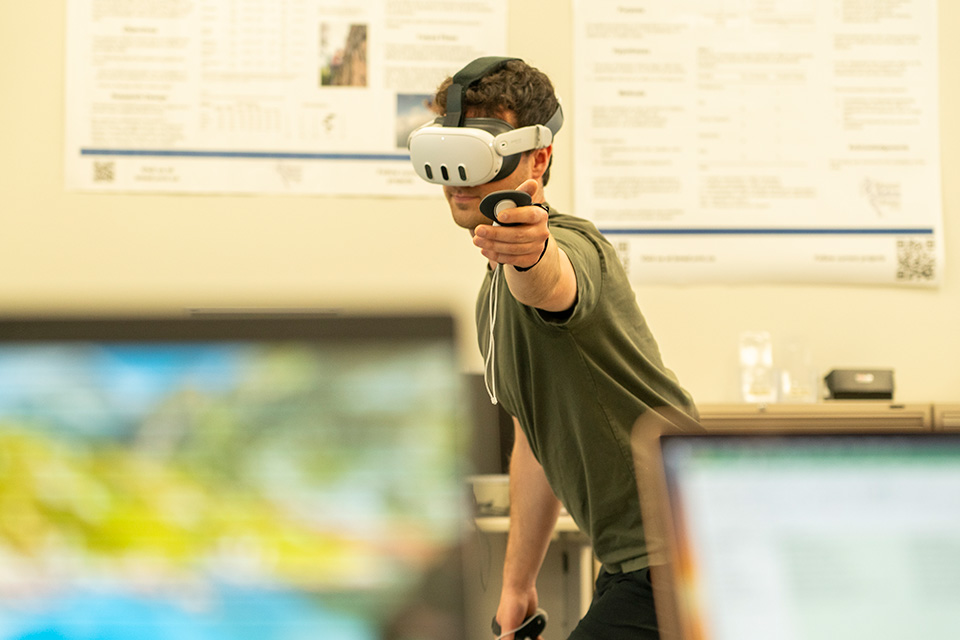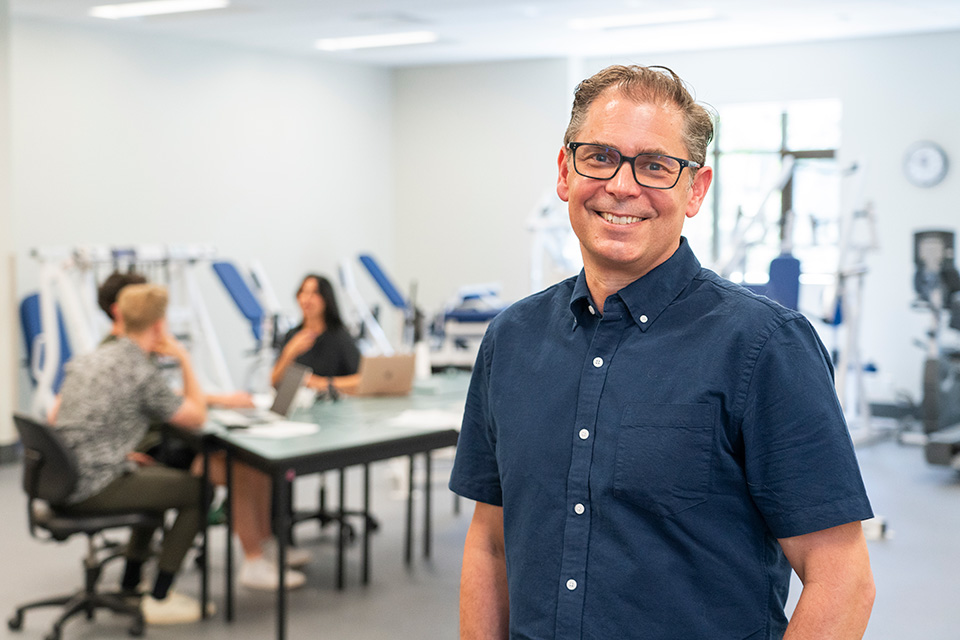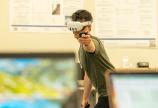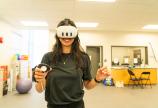Immersive workout

She was no boxer but, wearing a virtual reality (VR) headset, she jabbed, dodged and swayed in the ring while tagging moving targets that were colour-coordinated and matched up with her boxing gloves.
He held two bats as differently coloured targets flowed toward him in his VR headset at different speeds and levels of difficulty. He swung at them and was forced to reach, lunge or squat to hit the mark.
They both got a workout.
Most people know that engaging in regular physical activity is good for physical and mental health. But it’s hard to find the motivation—or energy—as the work-life grind can often make health and wellness drop way down the priority list.
“We focus on closing the infamous intention-behaviour gap,” explains Ryan Rhodes, a professor in UVic’s School of Exercise Science. “People have the best of intentions but struggle, at times, to actually change their behaviour.”
The boxing and batting exercises were part of a recent University of Victoria study published in JMIR Serious Games on Tuesday that measures how well VR fitness apps impact a person’s mood. Over two sessions, 24 individuals engaged with two different modes of Supernatural, the leading VR fitness app on the Meta Quest headset. Measures of physical activity/fitness were taken including heart rate, calories burned and mood changes.
The results show that the VR app can serve as an effective form of physical activity, with similar results to that of running or completing a high-intensity interval workout, with potential benefits for both mental and physical health.

Why people exercise—or not
Rhodes and his colleagues at UVic’s Behavioural Medicine Laboratory have for two decades focused their research on the psychology of physical activity and sedentary behaviour—why people choose to exercise, or not, and how to change their behaviour.
The lab has studied “exergames,” for many years such as Nintendo’s popular Wii Fit, which allowed users to play virtual tennis and other games using a handheld controller. At the core of Rhodes’ research interest is “the psychology of enjoyment and being engaged in what you’re doing.”
“A lot of exercise is an act of willpower for people,” he says. “Let’s face it, running on a treadmill is not exactly a fun, engaging activity. We do it because it’s good for us but, ultimately, it can be difficult to stick with it.”
Immersive VR technology takes early exergames to the next level, now providing programs that can give users an intense workout.
Whole-body flow
“When you’re doing something like this VR app, it really feels like you’re standing in the middle of Antarctica or you could be on a beautiful beach. That can add to the experience,” Rhodes says, noting that as programs become more sophisticated and immersive, they increasingly focus on whole-body movement such as aerobic activity and activating different muscle groups.
The lab’s latest research was funded by the immersive technology company, Within, and led by primary author and PhD student Tabitha Craig and co-authors Rhodes, and postdoctoral fellow, Yoah Sui. The research team used the Meta Quest mixed reality headset to test the effects of Supernatural’s boxing and flow modes. The latter “is a 360-degree, untethered VR experience, complete with squats, lunges, and turns that target every major muscle group to get the heart pumping.”
“As technology advances the experience is similar to going on a run or a brisk walk or a bike ride—high-quality cardiovascular activity,” says Craig, noting the activity also carries mental health and wellness benefits for participants.
“Participants reported that they felt more vigorous, full of pep and active after completing their sessions,” she says. The VR fitness app can ultimately be a “gateway activity” that helps a user start to get active in a safe, private setting.
Rhodes and team are researching other related areas, including self-regulation, emotion regulation, habit formation and how a sense of identity around physical activity in families can help raise children who are committed to long-term, active lifestyles.
“How do we shift people saying, ‘I exercise’ to ‘I am an exerciser,’ and how that sense of identity then reflects self-regulation.”
The lab, which is supported by the Canadian Institutes of Health Research, Diabetes Canada, the Social Sciences and Humanities Research Council of Canada, and Worksafe BC, reinforces UVic’s commitment to leadership around the United Nations Sustainable Development Goals, specifically SDG 3, to "ensure healthy lives and promote well-being for all at all ages."
Photos



In this story
Keywords: health, research, sdg3, technology, exercise science, education
People: Ryan Rhodes




